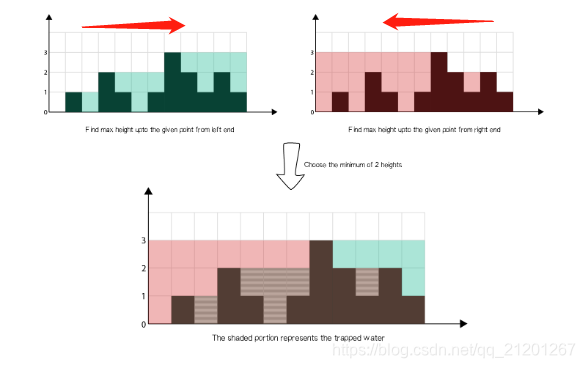文章目录
- 1. 题目
- 2. 解题
- 2.1 正反扫描法
- 2.2 双指针
- 2.3 单调栈
1. 题目
给定 n 个非负整数表示每个宽度为 1 的柱子的高度图,计算按此排列的柱子,下雨之后能接多少雨水。

上面是由数组 [0,1,0,2,1,0,1,3,2,1,2,1] 表示的高度图,在这种情况下,可以接 6 个单位的雨水(蓝色部分表示雨水)。 感谢 Marcos 贡献此图。
示例:
输入: [0,1,0,2,1,0,1,3,2,1,2,1]
输出: 6
来源:力扣(LeetCode)
链接:https://leetcode-cn.com/problems/trapping-rain-water
著作权归领扣网络所有。商业转载请联系官方授权,非商业转载请注明出处。
2. 解题
类似题目:
LeetCode 11. 盛最多水的容器(双指针)
LeetCode 84. 柱状图中最大的矩形(单调递增栈)
2.1 正反扫描法

- 正向扫描记录每个位置的历史最大值存入,反向亦然
- 每个位置取上面得到的较小的值减去自身高度
class Solution {
public:int trap(vector<int>& h) {if(h.empty())return 0;int i = 0, s = 0, n = h.size();int Lmax[n], Rmax[n];Lmax[0] = h[0];for(i = 1; i < n; ++i)Lmax[i] = max(h[i],Lmax[i-1]);Rmax[n-1] = h[n-1];for(i = n-2; i >= 0; --i)Rmax[i] = max(h[i],Rmax[i+1]);for(i = 1; i < n-1; ++i)//两边永远装不了水s += min(Lmax[i],Rmax[i])-h[i];return s;}
};
2.2 双指针
class Solution {
public:int trap(vector<int>& h) {if(h.empty())return 0;int l = 0, r = h.size()-1, s = 0;int Lmax = 0, Rmax = 0;while(l < r){if(h[l] < h[r])//右边肯定有堵高墙{h[l] >= Lmax ? (Lmax = h[l]) : s += Lmax-h[l];//我不是左边最高的,就能盛水++l;}else//h[l] >= h[r], 左边肯定有堵高墙{h[r] >= Rmax ? (Rmax = h[r]) : s += Rmax-h[r];//我不是右边最高的,就能盛水--r;}}return s;}
};
2.3 单调栈
- 单调递减栈相当于维护了左边的高墙
- 遇到当前位置大于栈顶元素,就找到右边高墙
- 计算栈顶元素可以接水量,删除栈顶
- 循环判断直到当前位置 <= 栈顶(不能储水)
class Solution {
public:int trap(vector<int>& h) {if(h.empty())return 0;int s = 0, top, distance, height;stack<int> stk;for(int i = 0; i < h.size(); ++i){while(!stk.empty() && h[i] > h[stk.top()])//当前墙高于左边的,违反递减{ //需要把中间高度比我小的处理掉,保持栈内单调递减top = stk.top();//左边的墙 位置记为top(待处理的)stk.pop();//删除之(处理掉)if(stk.empty())//top它没有左边围墙了break;distance = i-stk.top()-1;//top左边还有墙height = min(h[i],h[stk.top()]) - h[top];//两边的最低高度(水高) - 自身高度(容器厚度)s += distance*height;}//处理完了,现在栈内是递减的了 或者 空stk.push(i);//递减的话会一直push进来(一个\斜坡,存不住水)//一旦不是斜坡了,进入上面的循环}return s;}
};






)


词向量之CBOW](http://pic.xiahunao.cn/[Paddle2.0学习之第四步](下)词向量之CBOW)

)



)




